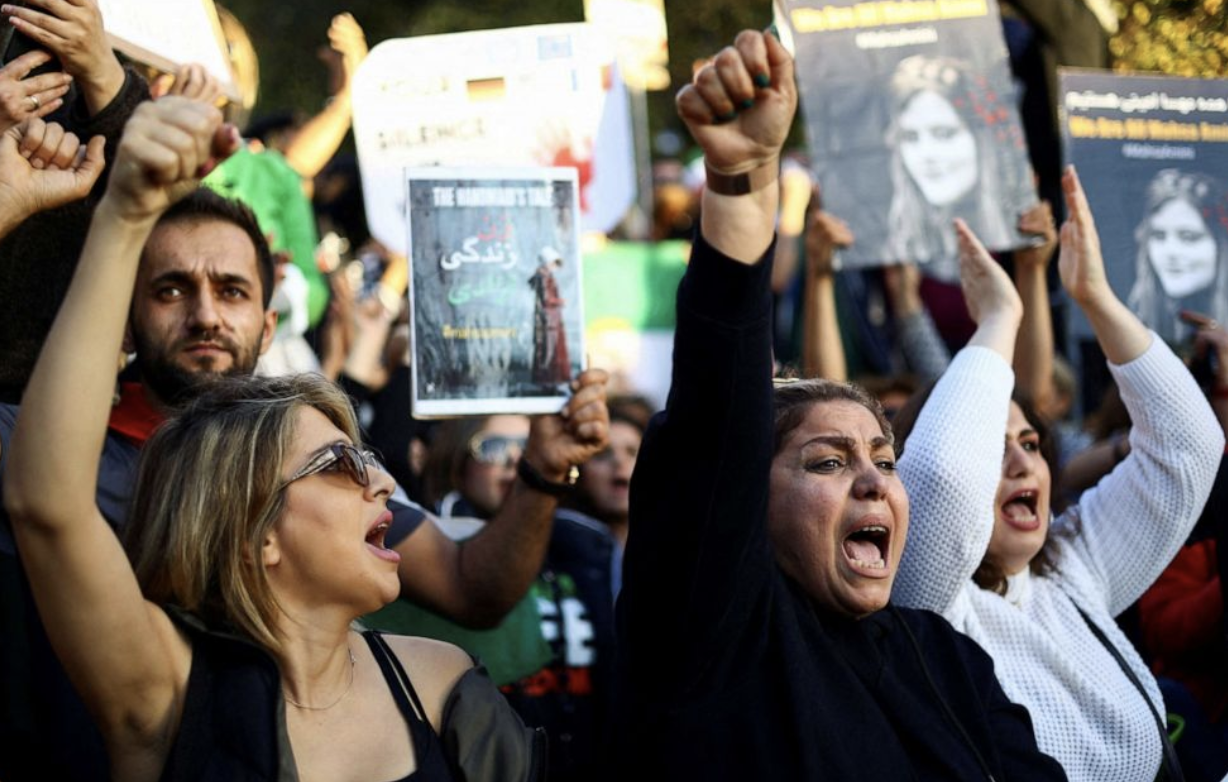The death of Mahsa Amini, a 22-year-old Kurdish Iranian, in Tehran on September 16, 2022, has triggered a series of protests and demonstrations throughout the country. She was held in police custody for three days prior to her passing, arrested by the “morality police” for breaking a dress code policy that requires Iranian women to wear hijabs, or headscarves. She was consequently taken away to a “reeducation center.” Iranian Police claimed that she suffered from a heart attack during her training on hijab rules before being taken to the hospital, and even released surveillance camera footage depicting a woman fainting while in custody. Amini’s family insisted this could not be the case, as she was perfectly healthy at the time.
A witness informed Amini’s cousin, Erfan Mortezaei, that she was tortured in the police van on the way to the station. He alleges that Amini was already lightheaded when she arrived at the station, and it took half an hour before an ambulance arrived to pick her up, then another hour and a half before she arrived at the hospital. She was apparently dealt a blow to the head and was brain-dead when she arrived at Kasra Hospital. Amini’s brother was attacked with pepper spray upon protesting his sister’s arrest.
Recent developments in Iran have reignited the critiques of the Islamic Republic and its Supreme Leader, Ayatollah Ali Khamenei. However, the role the United States played in how these parties seized power in Iran often goes unrecognized in such conversations, given the gravity of it in the first place. These events can be traced back to American intervention.
The contemporary struggle for power in Iran can be drawn back to 1953, when Prime Minister Mohammed Mosaddeq completed two terms. During his time in power, he led the movement to nationalize the Iranian oil industry, which the British, American, and French had 40 percent stake in at the time. His government was consequently toppled by a royalist military coup backed by the CIA and British Secret Intelligence Service. The United States instated Shah Mohammad Reza Pahlavi as the leader of Iran, transitioning Iran from a constitutional monarchy into a royal dictatorship.
The critical issue here is that Pahlavi was perceived by the Iranian public as too Western to be socially acceptable, which ultimately led to the rise of Islamic extremist thought and the Islamic Revolution that deposed Pahlavi and created the Islamic Republic. The American belief that Western policies and political behaviors are the only kind that can be progressive or democratic fully ignores the cultural nuances that exist in spheres outside of the United States. It is often explained that Pahlavi’s push for modernization is what triggered anti-American, religion-based reactions; however, it was the introduction of American definitions of modernity, such as secularity, as well as his close economic ties with the United States and Britain, that was socially and politically unsuitable for the particular cultural regularities and established order of Iranian society. It does not help that the public easily recognized and resented the fact that Pahlavi had become a puppet for Western influence and command. The current government is the very regime that overthrew Pahlavi in 1979, now run by Ayatollah Khameinei, instated as the Supreme Leader of Iran. This new leadership gradually instituted political and social change congruent with their religious ideologies, culminating in the recent strings of dress code mandates.
In a rare instance of 21st century Iranian resistance, protests against the Iranian government and the morality police have spread across multiple cities in Iran. As of September 22, 2022, the government has reported 17 casualties. Videos of the demonstrations from BBC Persia depict women burning hijabs and cutting off their hair in protest. Sentiment against the government has grown not only as a result of the strict dress code laws but also general anger over living conditions in an economy that has suffered from years of mismanagement, US-led sanctions, and corruption. These sanctions are in response to Iran’s nuclear and missile program and are making it very difficult for Iran to sell its oil, an export the country relies on heavily.. Thus, Iranian citizens have had to struggle through inflation reaching 41 percent, food shortages, and supply disruptions. Now, many wish to end the religious restrictions that govern people’s dress, socialization, and even what they drink and eat. Calls to end the Islamic Republic in Iran are met with a brutal response: Security forces have attacked protestors with gunshots, water cannons, and batons. Internet usage and signal access has been heavily restricted as well.
Women and their allies have taken to the streets in Iran in an attempt to gain back some of their autonomy, reminding the Iranian government of a time before the Islamic Revolution triggered by American intervention. Protests have reached other countries, urging their own governments to aid resistance efforts particularly through discouraging the Iranian government from further harming protestors or persisting in corruption. Perhaps the most coalesced rebellion in a considerable amount of time, the recent string of demonstrations might have the power to change Iranian policies once and for all.
